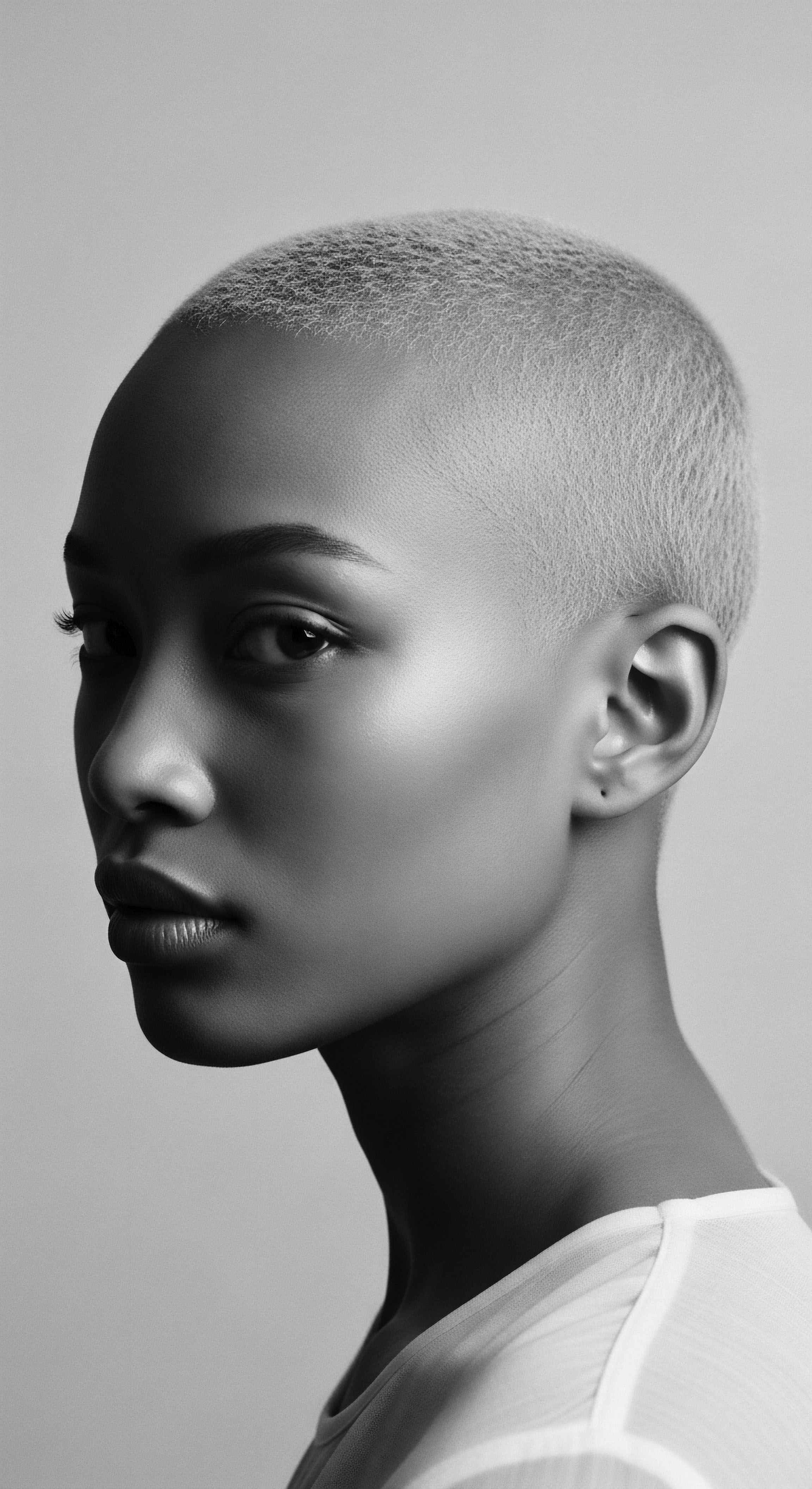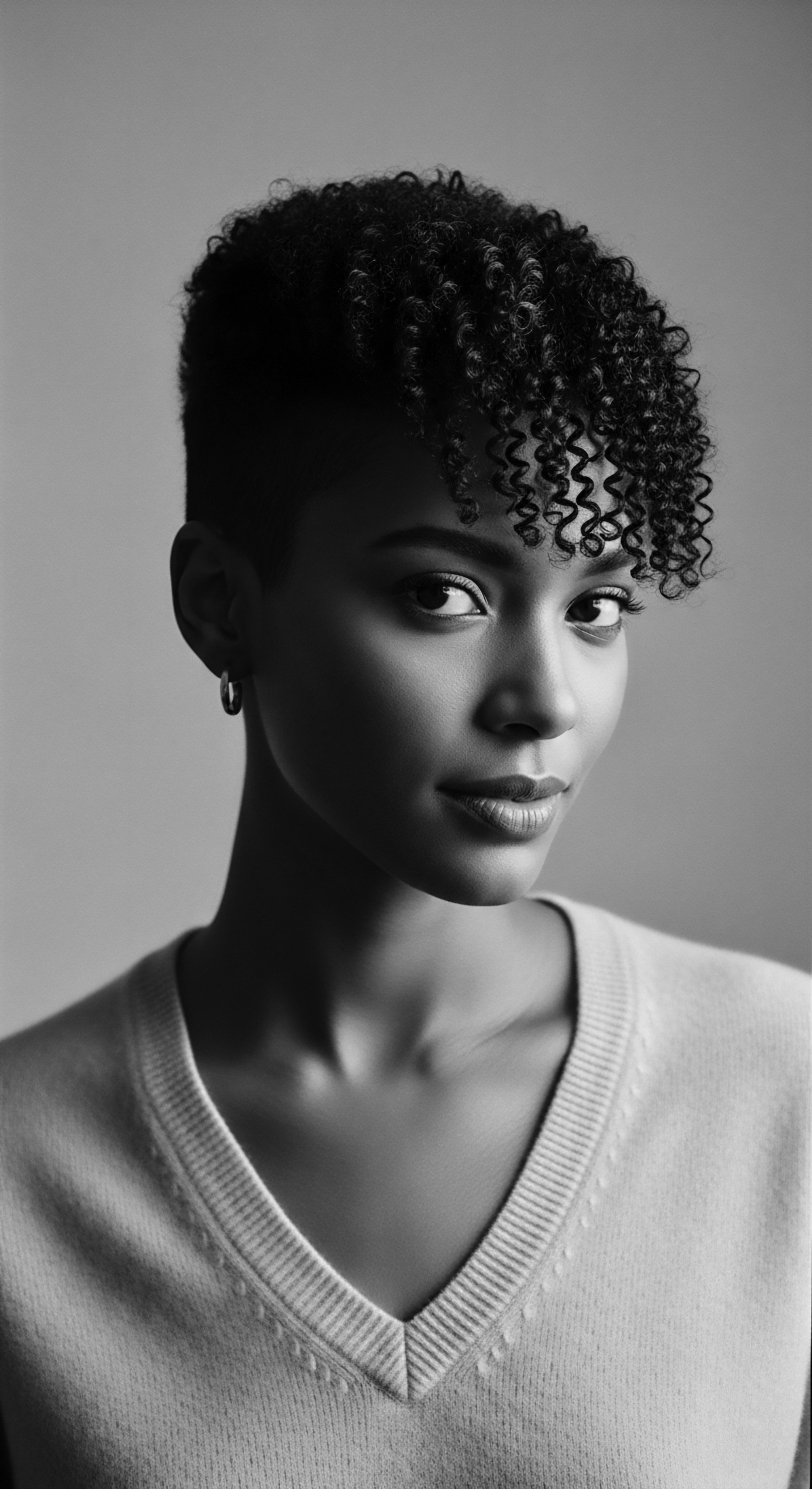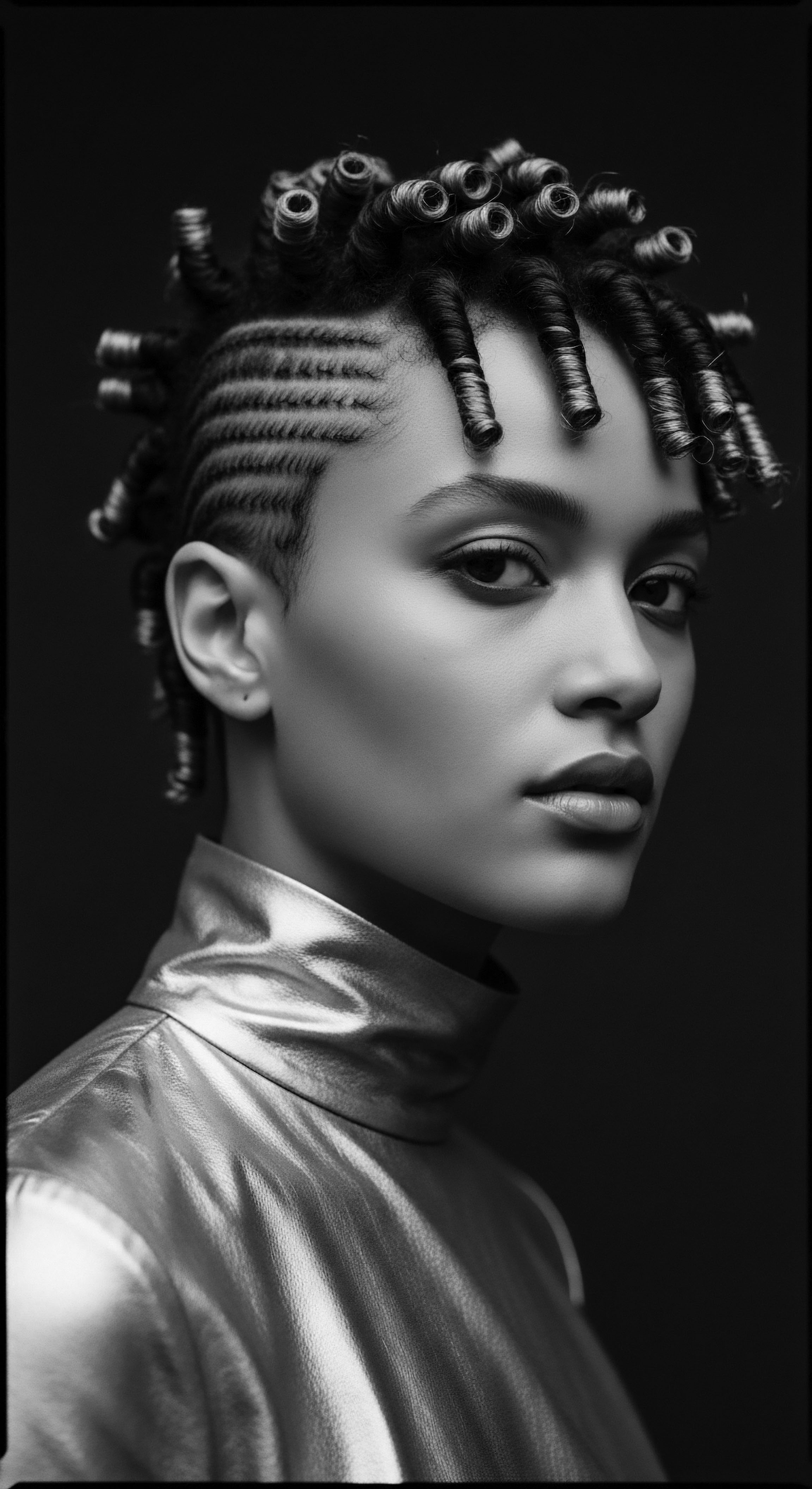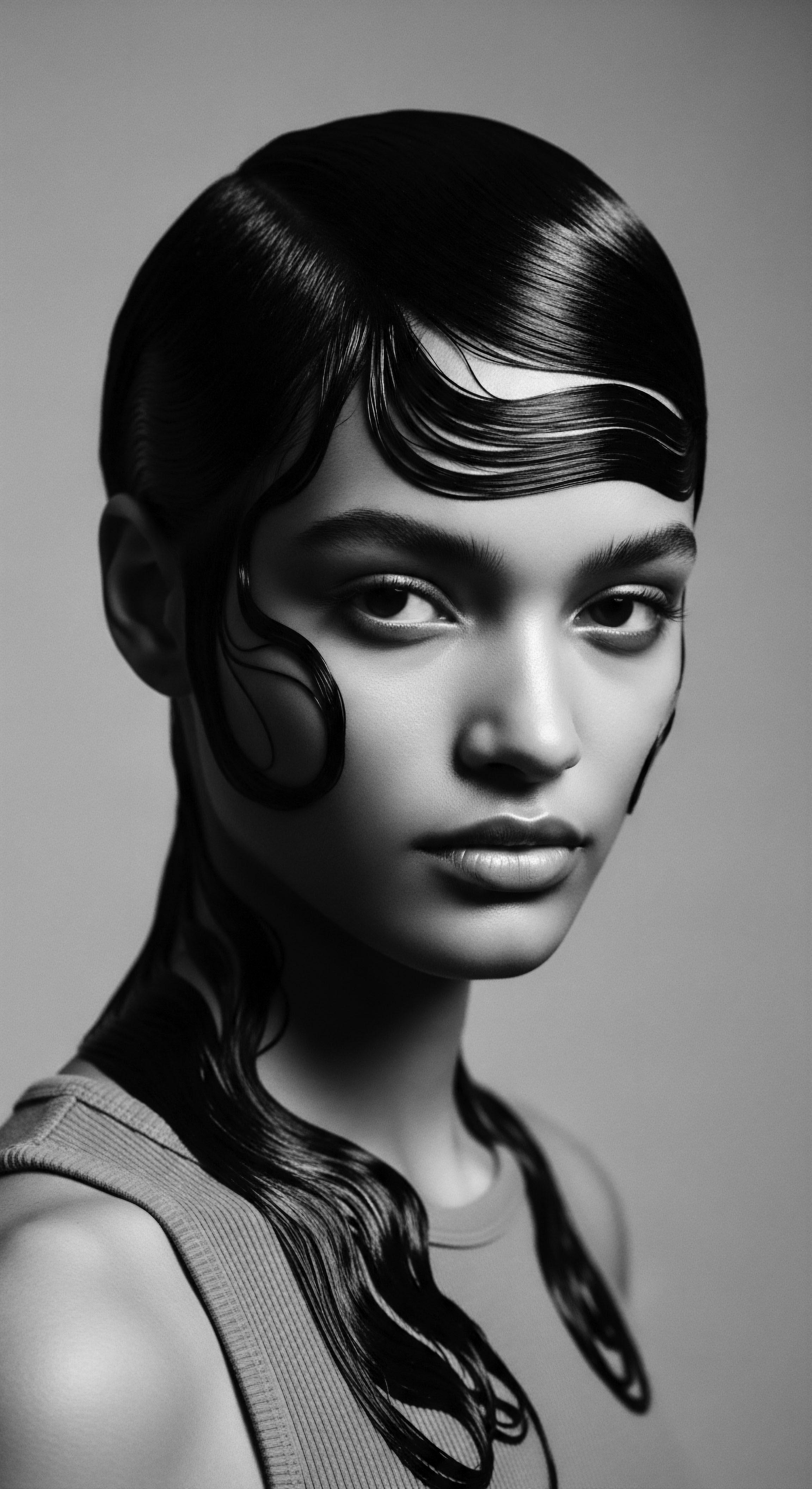
Roots
Consider the radiant sun, that life-giver. For generations, for millennia even, the very forces that sustained life also shaped human experiences, including the journey of textured hair. Our ancestors, living in climates where the sun’s embrace was constant and often intense, did not merely exist beneath its rays. They developed an intimate understanding of its power, devising ingenious practices to live in harmony with it, protecting what was vital, including their hair.
This ancestral wisdom, passed down through the ages, forms the bedrock of textured hair heritage. It is a story not of simple survival, but of thoughtful adaptation, a profound dialogue between human ingenuity and the natural world.

A Crown Against The Sun ❉ The Biology of Textured Hair
The unique architecture of textured hair, with its spiraled and tightly coiled structure, served as an evolutionary shield. Scientific inquiry suggests that this characteristic form, deeply rooted in the origins of humankind, was a natural adaptation to intense ultraviolet radiation in equatorial regions. (Jablonski & Chaplin, 2014b) The coils create a natural loft, allowing air to circulate close to the scalp, cooling it while simultaneously providing a dense canopy of protection against the sun’s direct assault. This inherent protective quality, often overlooked in contemporary conversations about textured hair, represents an ancient defense mechanism, a testament to the body’s innate ability to adapt to its environment.
Dark skin, rich in melanin, offered significant UV protection, and the same melanin that darkens skin also darkens hair. This dual shield—melanin in the strands and the inherent coiling pattern—acted as a first line of defense for those living in sun-drenched landscapes.
The coiled architecture of textured hair provided an ancient, natural shield against the sun’s potent rays.

The Elemental Veil ❉ Natural Oils and Clay Pastes
Beyond its biological design, human hands, guided by generations of observation and tradition, fashioned external protections. Across diverse African communities, and among Indigenous peoples worldwide, natural elements from the earth became the earliest sunscreens and conditioning treatments for hair.
- Shea Butter ❉ From the karite tree of the Sahel belt, shea butter was a vital ingredient. It offered deep hydration and healing for skin and hair, acting as a barrier against harsh climates. Its rich composition, packed with vitamins A, E, and F, also provided UV protection.
- Coconut Oil ❉ A staple in many tropical regions, including Polynesia and parts of Africa and Asia, coconut oil was widely used as a moisturizer and a sun protector. It penetrates the hair shaft, reducing protein loss and helping to shield against sun exposure and environmental damage.
- Tamanu Oil ❉ Hailing from Polynesian traditions, tamanu oil was prized for its ability to shield hair and skin from the sun’s drying effects, acting as a natural film-former on the hair surface.
- Monoi Oil ❉ An ancestral preparation from French Polynesia, created by macerating tiare flowers in coconut oil, Monoi oil nourished hair, protecting it from sun exposure through its high fatty acid content.
- Otjize Paste ❉ The Himba tribe of Namibia stands as a poignant example. They historically coated their hair and skin in a red paste called Otjize, a mixture of butterfat and red ochre. This distinctive practice served not only as a cultural identifier but also as a practical shield against the intense sun and insects. This specific historical example powerfully illuminates the connection to textured hair heritage and ancestral practices. The butterfat would have created a physical barrier, while the red ochre, a mineral pigment, could have offered some reflective or absorptive properties against solar radiation.
These practices illustrate a profound wisdom, an understanding that external application of nature’s bounty could augment the hair’s inherent protective qualities. It was a conscious act of care, using what the land provided to safeguard one’s most visible crown.

From Nature’s Pharmacy ❉ Botanical Contributions to Sun Protection
Beyond well-known oils and clays, diverse botanical extracts contributed to sun protection and overall hair vitality. The knowledge of these plants was often specific to their indigenous environments and passed down through generations.
- Aloe Vera ❉ Used in Native American and Latin American traditions, aloe vera gel hydrated hair and skin, soothing after sun exposure and providing protective qualities against harsh weather.
- Amla (Indian Gooseberry) ❉ A cornerstone of Ayurvedic hair care in India, amla oil, rich in vitamin C and antioxidants, nourished the scalp and strengthened hair, believed to shield against environmental aggressors.
- Blue Cypress Leaf Extract ❉ Australian indigenous plants, known for their resilience in extreme climates, contained cellular extracts with high antioxidant content. Blue Cypress Leaf, for instance, helped shield hair from sun damage and pollutants.
These botanical applications speak to a sophisticated ethnobotanical understanding, where specific plants were chosen for their perceived properties, often aligning with modern scientific insights into antioxidant and UV-protective compounds.

Ritual
The practices of shielding textured hair from solar intensity were rarely isolated acts of utility. They were, more often, embedded within larger traditions, woven into the social fabric, and infused with cultural meaning. These regimens and styles were expressions of identity, community, and ancestral continuity.
They illustrate how hair care was not a solitary task but a communal ritual, often passed from elder to youth, holding stories and wisdom within each strand. This historical understanding broadens our view of “protection” to include not just physical safeguarding, but also the preservation of cultural lineage.

Protective Styles ❉ A Woven Defense
The creation of protective hairstyles served as a primary method for mitigating environmental harm, including sun exposure, while also communicating identity. Braiding, twisting, and wrapping techniques, dating back thousands of years in Africa, offered not only aesthetic beauty but also a practical defense.
African hair braiding, with roots as ancient as 3500 BC, consistently offered protection from the scorching African sun. These styles, from intricate cornrows to robust twists, kept the hair tucked away from direct sunlight, reducing dryness and damage. They also minimized manipulation, allowing hair to retain moisture and length, which contributed to overall strand health.
| Style Name or Type Cornrows |
| Cultural Origin Ancient Africa, dating to 3500 BC |
| UV Protection Aspect Tightly woven to the scalp, they cover and shield the scalp and hair length from direct sun exposure. |
| Style Name or Type Box Braids |
| Cultural Origin South Africa (at least 5,000 years ago) |
| UV Protection Aspect Encases sections of hair, protecting the individual strands from environmental damage, including UV. |
| Style Name or Type Fulani Braids |
| Cultural Origin West Africa (Fulani people) |
| UV Protection Aspect Often adorned with beads and shells, these styles still offer substantial coverage, protecting strands and scalp. |
| Style Name or Type Himba Ozondato |
| Cultural Origin Namibia (Himba tribe) |
| UV Protection Aspect Braids coated with otjize paste provide both physical barrier and potential mineral UV reflection. |
| Style Name or Type These styles represent a living heritage of ingenuity, where artistry and practicality combined for hair preservation. |

Head Wraps ❉ Fabric Against the Fierce Sun
Head wraps, known by names like Dukus in Ghana, Geles in Nigeria, and Doeks in South Africa, served as powerful symbols of culture, status, and spirituality. Beyond their symbolic weight, head wraps were a straightforward and effective physical barrier against the sun’s rays. They provided broad coverage for the hair and scalp, reducing direct exposure and protecting against the drying effects of intense heat.
The widespread practice of hair wrapping across the African diaspora, extending into the Americas, speaks to its utility and cultural resonance. While at times co-opted or mandated during periods of oppression, Black women consistently reclaimed these coverings as statements of dignity and self-love, even using them to protect hair from sun, sweat, and dirt. The continuity of this tradition into modern times, often used for protective styling or simply as a quick cover, underscores its enduring relevance in safeguarding textured hair.
Head wraps, far from mere adornment, served as functional shields, embodying resilience and cultural continuity.

An Internal Fortification ❉ The Role of Diet and Nutrition
Ancestral wisdom extended beyond topical applications and external coverings. A deep understanding of internal nourishment for hair health also characterized historical practices, indirectly contributing to the hair’s ability to withstand environmental stressors like UV radiation. While direct historical claims of dietary UV protection for hair are scarce, a robust diet supporting overall hair health would certainly bolster its resilience.
Traditional diets, rich in natural, unprocessed foods, provided essential nutrients that underpin hair vitality.
- Proteins ❉ Hair is primarily composed of keratin, a protein. Ancestral diets often included lean meats, fish, beans, and nuts, providing the necessary building blocks for strong hair. A lack of adequate protein can lead to weak, brittle strands.
- Omega-3 Fatty Acids ❉ Found in oily fish, flaxseeds, and certain plant sources like avocado and pumpkin seeds, these healthy fats are vital for scalp hydration and nourishing the hair shaft. A well-hydrated scalp and hair are better equipped to resist environmental drying and damage.
- Vitamins and Minerals ❉ Foods rich in vitamins A, C, E, and B complex, alongside minerals like zinc and iron, contributed to overall hair health.
- Vitamin A helps produce sebum, the scalp’s natural conditioner.
- Vitamin C, a powerful antioxidant, supports collagen production, vital for hair strength and elasticity.
- Vitamin E also acts as an antioxidant, boosting circulation to hair follicles and helping repair damaged ones.
This holistic view, where what goes into the body directly influenced the health of one’s hair, speaks volumes about the ancestral connection to wellbeing. Healthy hair, nurtured from within, would inherently possess a greater capacity to withstand the elements, including the sun’s harsh touch.

Relay
The profound wisdom of historical hair practices, particularly those aimed at shielding textured hair from the sun’s reach, is not merely a relic of the past. It serves as a living archive, a continuous relay of ancestral ingenuity that holds significant resonance in our contemporary understanding of hair science and holistic well-being. Examining these traditions through a modern scientific lens allows us to appreciate the sophistication inherent in what might appear to be simple, age-old solutions. This connection to heritage informs and enriches present-day care, demonstrating how ancient wisdom often aligns with current research in complex, multi-dimensional ways.

Bridging Ancient Wisdom and Modern Understanding
How does the ingenuity of our ancestors align with today’s scientific insights regarding hair protection? The historical use of oils and butters for textured hair, for instance, finds validation in contemporary science. These natural substances, rich in fatty acids and antioxidants, create a protective barrier on the hair shaft.
This barrier helps to seal in moisture and reduce protein loss, countering the drying and damaging effects of ultraviolet radiation. The physical coating helps to deflect some UV rays, while the antioxidants combat free radical damage caused by sun exposure, thereby maintaining the hair’s integrity and vibrancy.
Consider the Himba’s use of Otjize. The butterfat component provides a thick, emollient layer, offering physical protection and moisture. The red ochre, a mineral pigment, may possess reflective properties that aid in sun defense, similar to how modern mineral sunscreens operate with zinc oxide or titanium dioxide. This practice, therefore, combines mechanical shielding with potential mineral reflection, a sophisticated approach without the benefit of a laboratory.
Historical hair care methods, often rooted in natural ingredients, frequently align with modern scientific principles of protection and nourishment.

The Enduring Legacy of Protective Styling
The historical prevalence of protective hairstyles in communities with textured hair speaks to an intuitive grasp of hair mechanics and environmental protection. Braids, twists, and locs reduce the hair’s surface area exposed to direct sunlight and minimize physical manipulation. This reduction in exposure and handling helps to prevent breakage, retain moisture, and maintain hair health over extended periods, making the hair more resilient to external stressors, including solar radiation.
This strategy also limits the interaction of UV rays with the hair’s internal structure. Hair, especially darker hair, contains melanin, which acts as a natural photoprotectant. However, prolonged or intense UV exposure can still degrade melanin and hair proteins. Protective styles, by virtue of their configuration, offer an additional layer of defense.

Sun’s Invisible Touch ❉ Understanding UV Damage to Hair
Ultraviolet radiation, specifically UVA and UVB rays, can cause significant harm to hair. UV exposure oxidizes hair’s melanin, leading to color changes, and degrades hair proteins, particularly keratin, weakening the hair shaft. This can result in dryness, brittleness, reduced elasticity, split ends, and a dull appearance. For textured hair, which already has a tendency towards dryness due to its coiled structure making natural oils less evenly distributed, UV damage can exacerbate these challenges.
The understanding of this damage was not necessarily scientific in historical contexts, but the observed consequences—dryness, breakage, loss of vitality—were directly addressed through practices that, in hindsight, offered effective mitigation. The ancestral emphasis on sealing in moisture and creating physical barriers was, in essence, a direct counter to the drying and degrading effects of the sun.

The Living Archive ❉ Ancestral Practices and Modern Wellness
The shift from merely aesthetic considerations to a holistic perspective of hair wellness is a return to ancestral sensibilities. Modern hair science now seeks to understand how botanical extracts, once mainstays of traditional care, offer benefits. For example, ingredients like those found in Australian native plants (Banksia Flower, Blue Cypress Leaf), rich in antioxidants, combat oxidative stress and shield hair from environmental aggressors, including sun damage. This scientific validation reinforces the profound knowledge held within traditional systems.
The holistic influence on hair health, drawing from ancestral wellness philosophies, also extends to internal nourishment. The modern emphasis on diets rich in protein, omega-3s, and vitamins mirrors the nutritional wisdom practiced for centuries to foster overall well-being, which in turn contributed to healthier, more resilient hair. (Holistic Hair, 2024) This comprehensive approach, encompassing external application, protective styling, and internal nourishment, highlights a sophisticated ancestral blueprint for hair health that consciously or unconsciously shielded textured hair from UV damage. It is a heritage that invites us not only to remember but to actively integrate this deep knowledge into our present and future.

Reflection
The enduring legacy of practices that shielded textured hair from the sun is a quiet chorus, a testament to the profound relationship between humanity, nature, and lineage. It speaks of a deep wisdom, not always articulated in scientific terms, but lived and embodied through generations. From the inherent protective curl of the strand itself to the mindful application of earth’s oils and clays, or the intricate artistry of a braided crown, each practice whispers of a time when beauty and survival were intrinsically intertwined.
The cultural significance of these methods, particularly for Black and mixed-race communities, transcends mere function. They represent resilience, identity, and a continuous thread connecting past ingenuity to present self-expression.
In this living archive of textured hair heritage, we discern not just historical methods, but a philosophy of care that honors the natural world and the body’s innate capacities. The Himba’s earthen veil, the protective embrace of ancient braids, the nourishing touch of a hand-pressed oil—these are not relics. They are reminders that true care resides in understanding, respect, and a harmonious relationship with our environment and our ancestral roots. To acknowledge these practices is to recognize the brilliance of those who came before us, and to find guidance for our own journey toward hair wellness that is deeply resonant with the soul of each strand.

References
- Jablonski, N. G. & Chaplin, G. (2014b). The evolution of skin pigmentation and hair texture in people of African ancestry. Journal of Human Evolution, 71, 1-13.
- Holistic Hair. (2024). Nutrition for Healthy Hair.
